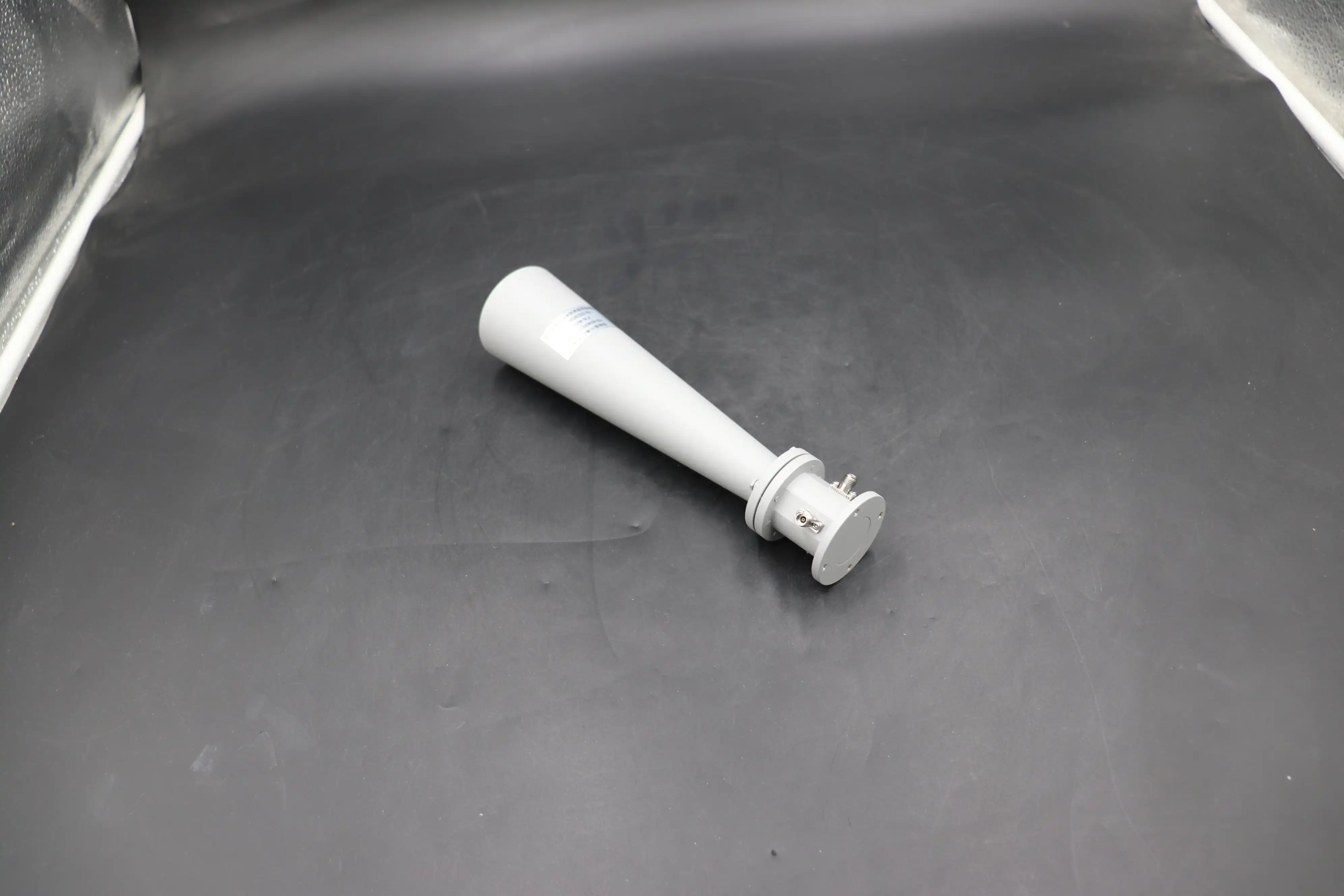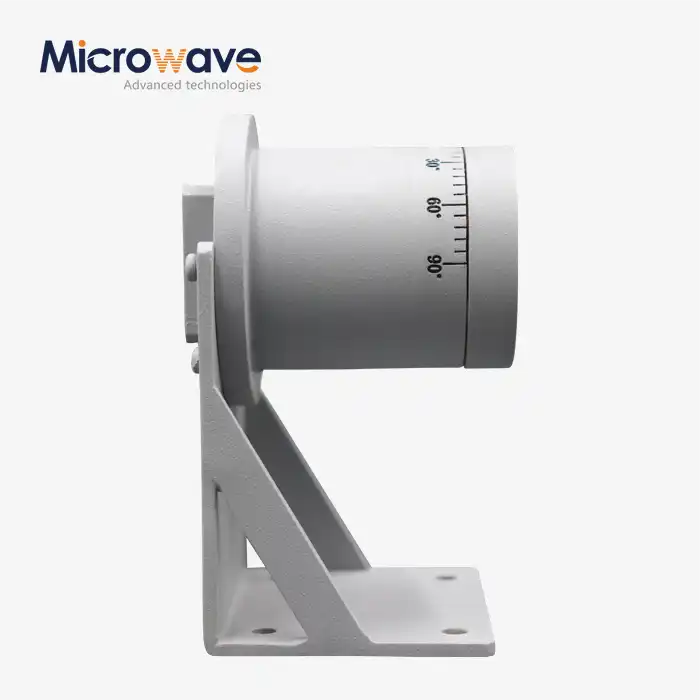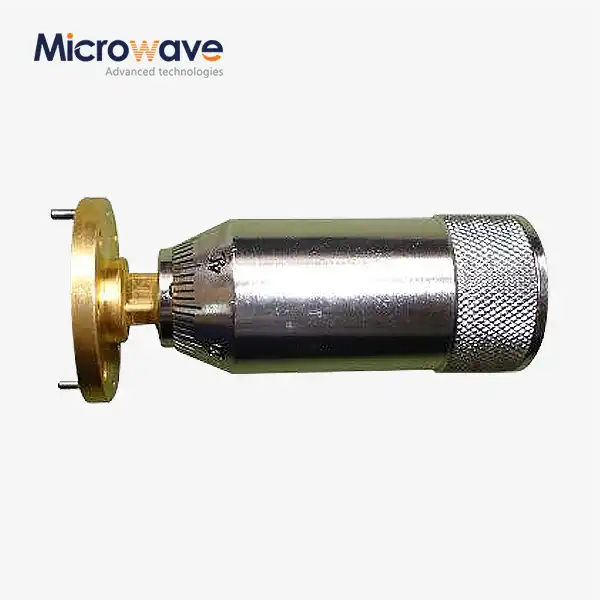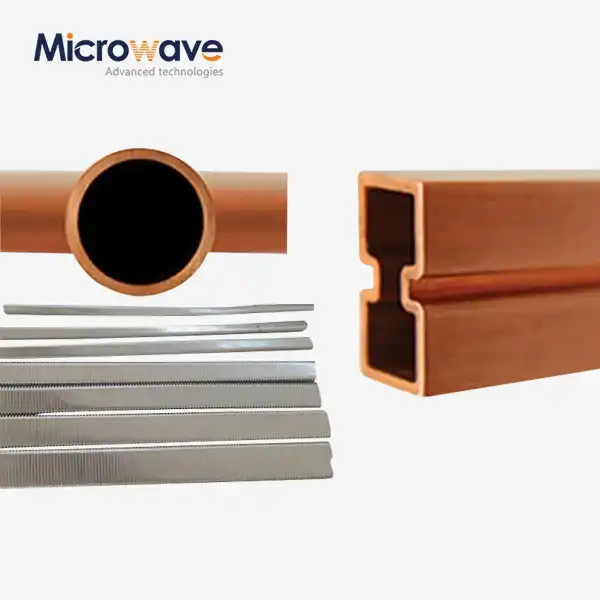What is the polarization of conical horn antenna?
When engineers face signal degradation issues in satellite communications or radar systems, understanding antenna polarization becomes critical. The polarization of conical horn antennas is primarily linear polarization, achieved through their symmetrical conical design that maintains consistent electromagnetic field orientation. A Conical Linear Polarization Horn Antenna offers exceptional signal stability and directional control, making it indispensable for high-frequency applications where precise signal transmission is paramount for mission-critical operations.
Understanding Conical Horn Antenna Polarization Fundamentals
Basic Principles of Conical Linear Polarization Horn Antenna Design
The polarization characteristics of conical horn antennas stem from their unique geometric configuration and electromagnetic field distribution patterns. Conical horn antennas typically offer multiple polarization options including Linear, Circular (RHCP/LHCP), Dual Linear and Dual Circular configurations. However, the fundamental design inherently produces linear polarization due to the symmetrical expansion of the electromagnetic fields as they propagate through the conical aperture. A Conical Linear Polarization Horn Antenna achieves its linear polarization through the controlled expansion of electromagnetic waves within the conical structure. The electric field vector maintains a consistent orientation throughout the propagation path, resulting in stable linear polarization characteristics. This design approach ensures minimal phase distortion and excellent impedance matching, particularly important for applications requiring high signal fidelity across wide frequency ranges from 1 GHz to 110 GHz. The manufacturing process of these antennas involves precision electroforming or whole processing techniques that maintain the critical dimensional tolerances necessary for optimal polarization purity. Advanced Microwave offers conventional horn antenna series that utilize these sophisticated manufacturing methods, ensuring consistent performance across their entire product line. The Conical Linear Polarization Horn Antenna design incorporates advanced materials and engineering principles that deliver superior electromagnetic performance while maintaining structural integrity under demanding environmental conditions.
Electromagnetic Field Distribution in Conical Horn Structures
The electromagnetic field behavior within a Conical Linear Polarization Horn Antenna follows well-established waveguide principles, modified by the gradual geometric transition from the feeding waveguide to the radiating aperture. The conical expansion allows for controlled impedance transformation while preserving the linear polarization characteristics of the input signal. This field distribution pattern ensures uniform radiation across the antenna's operational bandwidth, typically achieving gains of 20 dB or higher. The conical horn antenna's cone-shaped flare section expands symmetrically around the central axis, offering symmetrical radiation patterns and can handle circular polarization when properly configured. However, in its standard linear polarization configuration, the Conical Linear Polarization Horn Antenna maintains excellent cross-polarization discrimination, typically exceeding 25 dB isolation between orthogonal polarization components. The field distribution patterns within these antennas create highly directional radiation characteristics with low side lobe levels, making them ideal for applications requiring precise beam control. The symmetrical nature of the conical geometry ensures consistent performance across both principal planes, eliminating the asymmetric behavior often encountered in pyramidal horn designs. This symmetry is particularly valuable in satellite communication systems where consistent antenna patterns are essential for maintaining link quality across varying operational conditions.

Technical Specifications and Performance Characteristics
Frequency Range and Operational Parameters of Conical Linear Polarization Horn Antenna
The operational capabilities of modern Conical Linear Polarization Horn Antenna systems extend across an impressive frequency spectrum, typically covering 1 GHz to 110 GHz with exceptional performance consistency. This broad frequency coverage makes these antennas suitable for diverse applications ranging from traditional microwave communications to emerging millimeter-wave and terahertz applications. The antenna's input impedance is standardized at 50 ohms, ensuring compatibility with most RF systems and measurement equipment. Temperature stability represents another critical performance parameter, with high-quality Conical Linear Polarization Horn Antenna designs operating reliably from -40°C to +85°C. This extended temperature range capability stems from careful material selection and thermal design considerations. The antennas typically utilize aluminum construction with specialized corrosion-resistant coatings that maintain electrical performance while providing long-term durability in harsh environmental conditions. Connector configurations for these antennas include standard options such as SMA and N-type interfaces, with customizable alternatives available to meet specific system requirements. The lightweight design philosophy ensures ease of installation while maintaining mechanical stability under various mounting configurations. Weight optimization becomes particularly important in aerospace and satellite applications where every gram counts toward overall system performance and launch costs.
Gain Performance and Radiation Pattern Analysis
The gain characteristics of a Conical Linear Polarization Horn Antenna typically achieve 20 dB or higher, depending on the specific geometric parameters and frequency of operation. This high gain performance results from the efficient aperture utilization and controlled field distribution within the conical structure. The gain stability across the operational bandwidth demonstrates the superior engineering inherent in properly designed conical horn antennas, making them preferred choices for precision measurement applications. Radiation pattern analysis reveals the exceptional directional properties of Conical Linear Polarization Horn Antenna designs. The patterns exhibit low side lobe levels, typically -20 dB or better relative to the main beam, ensuring minimal interference with adjacent systems or frequencies. The half-power beamwidth remains consistent across both E-plane and H-plane measurements, reflecting the symmetrical nature of the conical geometry. This pattern stability proves invaluable in applications requiring precise spatial selectivity, such as radio astronomy or electronic warfare systems. Cross-polarization performance represents another critical specification, with quality Conical Linear Polarization Horn Antenna designs achieving better than -25 dB isolation between orthogonal polarization components. This excellent polarization purity ensures minimal signal degradation in systems sensitive to polarization distortion, such as coherent radar systems or precision satellite communication links. The stable polarization characteristics across the entire operational bandwidth demonstrate the sophisticated electromagnetic design principles employed in modern horn antenna development.
Applications and Industry Use Cases
Satellite Communication Systems Integration
Satellite communication systems represent one of the primary application areas for Conical Linear Polarization Horn Antenna technology. Ground station installations utilize these antennas for both uplink and downlink operations, taking advantage of their high gain and excellent polarization characteristics. The ability to maintain signal integrity across long propagation paths makes these antennas essential components in modern satellite networks, from traditional geostationary systems to emerging low Earth orbit constellations. The Conical Linear Polarization Horn Antenna design proves particularly valuable in satellite ground stations requiring high data rate capabilities. The antenna's wide bandwidth characteristics support multiple frequency bands simultaneously, enabling efficient spectrum utilization while maintaining excellent signal quality. The stable radiation patterns ensure consistent link performance regardless of satellite position within the coverage area, critical for maintaining service quality in commercial satellite communication operations. Feed network integration represents another significant advantage of Conical Linear Polarization Horn Antenna systems in satellite applications. The antennas can be configured as primary feeds for large reflector systems or as elements in phased array configurations. Their excellent impedance matching characteristics and low VSWR performance across wide bandwidths minimize system losses while maximizing power transfer efficiency. This efficiency becomes particularly important in high-power satellite communication systems where every decibel of performance translates to significant operational advantages.
Defense and Aerospace Applications
Military and aerospace systems demand the highest levels of performance and reliability from their antenna components, making Conical Linear Polarization Horn Antenna technology a natural choice for these demanding applications. Radar systems utilize these antennas for both transmit and receive functions, benefiting from their high gain and excellent pattern stability. The ability to operate across wide temperature ranges and harsh environmental conditions makes them suitable for deployment in diverse operational scenarios. Electronic warfare systems represent another critical application area where Conical Linear Polarization Horn Antenna performance characteristics provide significant advantages. The excellent cross-polarization discrimination and low side lobe levels minimize the risk of signal interception while maximizing jamming effectiveness. The wide bandwidth capabilities enable simultaneous operation across multiple threat frequencies, enhancing system versatility and operational effectiveness. Navigation and guidance systems in aerospace applications rely heavily on the precision characteristics of Conical Linear Polarization Horn Antenna designs. The stable phase center location and predictable radiation patterns ensure accurate direction finding and positioning capabilities. These characteristics prove essential in applications ranging from aircraft landing systems to precision missile guidance, where antenna performance directly impacts mission success rates and operational safety margins.
Telecommunications Infrastructure
Modern telecommunications infrastructure increasingly relies on Conical Linear Polarization Horn Antenna technology for point-to-point microwave links and base station applications. The antennas' high gain characteristics enable long-distance communication links while minimizing interference with adjacent services. Their ability to maintain consistent performance across wide frequency bands supports multiple communication standards simultaneously, improving network efficiency and reducing infrastructure costs. 5G and future 6G network deployments particularly benefit from the advanced capabilities of Conical Linear Polarization Horn Antenna systems. The millimeter-wave frequencies utilized in these networks require antennas with exceptional precision and stability, characteristics inherent in properly designed conical horn antennas. The ability to achieve high gains at these frequencies while maintaining acceptable side lobe levels proves critical for managing interference in dense urban environments. Backhaul network applications represent another significant market for Conical Linear Polarization Horn Antenna technology. The antennas provide reliable, high-capacity links between cell sites and central network facilities, supporting the ever-increasing data demands of modern mobile communications. Their weather-resistant design and long-term stability ensure consistent network performance regardless of environmental conditions, critical for maintaining service quality in commercial telecommunications networks.
Advanced Manufacturing and Customization Options
Precision Manufacturing Techniques for Conical Linear Polarization Horn Antenna
The manufacturing of high-performance Conical Linear Polarization Horn Antenna systems requires sophisticated production techniques and stringent quality control measures. Electroforming processes enable the creation of complex conical geometries with exceptional surface finish and dimensional accuracy. This manufacturing approach ensures consistent electromagnetic performance while enabling cost-effective production of both prototype and volume quantities. Computer numerical control (CNC) machining represents another critical manufacturing capability for Conical Linear Polarization Horn Antenna production. Modern horn antennas are fabricated using computer numerical control (CNC) milling technique approaches to streamline the manufacturing process. This precision manufacturing approach enables the creation of complex internal features and custom connector configurations while maintaining the tight tolerances essential for optimal electromagnetic performance. Quality assurance procedures throughout the manufacturing process ensure that each Conical Linear Polarization Horn Antenna meets or exceeds specified performance requirements. Advanced measurement facilities, including anechoic chambers and network analyzer test systems, verify antenna performance across the entire operational bandwidth. These comprehensive test procedures provide customers with confidence in product performance while identifying potential issues before shipment.
Custom Design Solutions and OEM Services
The diverse requirements of modern antenna applications often demand customized Conical Linear Polarization Horn Antenna solutions tailored to specific operational needs. Custom design services enable modification of standard antenna configurations to meet unique frequency, gain, or mechanical requirements. These customization capabilities prove particularly valuable for research applications or specialized commercial systems where standard products may not provide optimal performance. OEM (Original Equipment Manufacturer) services provide comprehensive support for customers integrating Conical Linear Polarization Horn Antenna technology into larger systems. Technical support services include antenna selection guidance, integration assistance, and performance optimization recommendations. This collaborative approach ensures that antenna performance complements overall system objectives while minimizing development time and costs. Prototyping services enable rapid evaluation of custom Conical Linear Polarization Horn Antenna designs before committing to full-scale production. Quick turnaround times on prototype development allow customers to verify performance characteristics and make necessary adjustments before final implementation. This iterative design approach minimizes technical risks while ensuring that final products meet all operational requirements. Global delivery capabilities ensure that customized antennas reach customers worldwide with appropriate logistics support and documentation.

Quality Standards and Compliance
International Certification and Standards Compliance
Modern Conical Linear Polarization Horn Antenna manufacturing adheres to stringent international quality standards, ensuring consistent performance and reliability across global markets. ISO 9001:2015 certification demonstrates commitment to comprehensive quality management systems throughout all aspects of antenna design, manufacturing, and customer service. This certification provides customers with confidence that products meet established quality benchmarks while supporting continuous improvement initiatives. Environmental compliance represents another critical aspect of Conical Linear Polarization Horn Antenna production. RoHS (Restriction of Hazardous Substances) compliance ensures that antennas meet environmental safety requirements while supporting sustainable manufacturing practices. ISO 14001:2015 environmental management certification demonstrates commitment to minimizing ecological impact throughout the product lifecycle, from raw material selection through end-of-life disposal considerations. Occupational health and safety standards, exemplified by ISO 45001:2018 certification, ensure that Conical Linear Polarization Horn Antenna manufacturing maintains the highest safety standards for employees and facilities. These comprehensive safety programs protect workers while supporting consistent product quality through proper training and safety protocols. The commitment to employee welfare contributes to stable manufacturing operations and consistent product delivery schedules.
Testing and Validation Procedures
Comprehensive testing procedures verify Conical Linear Polarization Horn Antenna performance across all specified parameters before product shipment. Advanced measurement facilities, including 24-meter anechoic chambers, enable precise characterization of antenna radiation patterns, gain, and polarization characteristics. These extensive test capabilities ensure that products meet or exceed published specifications while identifying potential performance issues before customer delivery. Near-field and far-field measurement capabilities provide complete antenna characterization across the operational frequency range. The Antenna Plane Near and Far Field Measuring Recombination Chamber enables detailed analysis of radiation patterns, gain variations, and impedance characteristics. This comprehensive measurement approach ensures that Conical Linear Polarization Horn Antenna products deliver consistent performance across their entire operational bandwidth, from 0.5 to 110 GHz. Reliability testing procedures subject Conical Linear Polarization Horn Antenna designs to accelerated environmental conditions, verifying long-term performance stability under extreme temperature, humidity, and vibration conditions. These extensive reliability tests provide customers with confidence in product longevity while identifying potential failure modes before field deployment. The combination of initial performance verification and long-term reliability testing ensures that antennas maintain specified performance throughout their operational lifetime.
Conclusion
Understanding the polarization characteristics of conical horn antennas reveals their fundamental linear polarization nature, achieved through symmetrical conical geometry and controlled electromagnetic field distribution. Conical Linear Polarization Horn Antenna technology provides exceptional performance across wide frequency ranges, from 1 GHz to 110 GHz, with superior gain characteristics and radiation pattern stability. These antennas serve critical roles in satellite communications, defense systems, and telecommunications infrastructure, where precise signal control and high reliability are paramount for mission success and operational effectiveness.
Cooperate with Advanced Microwave Technologies Co., Ltd.
Advanced Microwave Technologies Co., Ltd stands as a leading China Conical Linear Polarization Horn Antenna manufacturer with over 20 years of specialized experience in microwave antenna systems. As a premier China Conical Linear Polarization Horn Antenna supplier, we offer comprehensive OEM services, rapid prototyping capabilities, and custom design solutions tailored to your specific requirements. Our state-of-the-art 24m Microwave Darkroom and ISO-certified quality systems ensure every High Quality Conical Linear Polarization Horn Antenna meets the highest international standards.
Whether you're seeking Conical Linear Polarization Horn Antenna for sale or require competitive Conical Linear Polarization Horn Antenna price quotations, our expert team provides comprehensive technical support from initial consultation through final delivery. As a trusted China Conical Linear Polarization Horn Antenna wholesale provider and China Conical Linear Polarization Horn Antenna factory, we deliver reliable, high-performance antennas worldwide with exceptional after-sales support. Contact us at craig@admicrowave.com for immediate assistance with your antenna requirements.
FAQ
Q: What types of polarization can conical horn antennas support?
A: Conical horn antennas primarily support linear polarization, but can be configured for circular polarization (RHCP/LHCP), dual linear, and dual circular polarization through specialized feed networks and polarizers.
Q: What frequency ranges do conical linear polarization horn antennas typically cover?
A: Modern conical linear polarization horn antennas typically operate from 1 GHz to 110 GHz, with specific models optimized for particular frequency bands based on application requirements.
Q: How do conical horn antennas achieve high gain performance?
A: Conical horn antennas achieve high gain through their symmetric aperture design and controlled electromagnetic field distribution, typically delivering 20 dB or higher gain with excellent pattern stability.
Q: What are the main advantages of conical horn antennas over other antenna types?
A: Conical horn antennas offer symmetric radiation patterns, wide bandwidth operation, excellent cross-polarization discrimination, low VSWR, and superior mechanical stability compared to other directional antenna designs.
References
1. "Horn Antenna Theory and Applications" by A. W. Love, IEEE Press, 1976
2. "Antenna Engineering Handbook" by Richard C. Johnson, McGraw-Hill Professional, 1993
3. "Modern Antenna Design" by Thomas A. Milligan, John Wiley & Sons, 2005
4. "Microwave Horn Antennas" by P. J. B. Clarricoats and A. D. Olver, Peter Peregrinus Ltd., 1984












